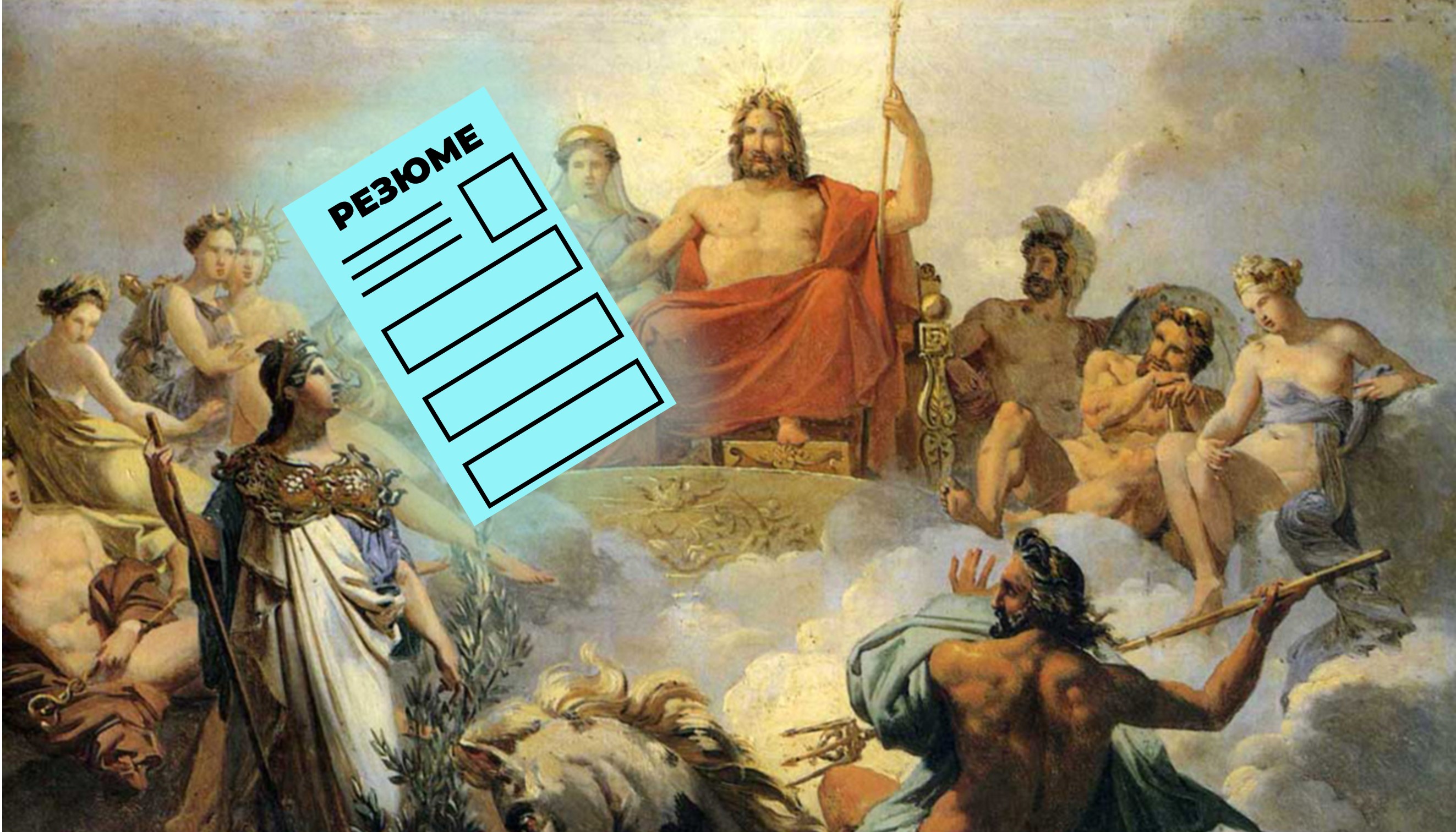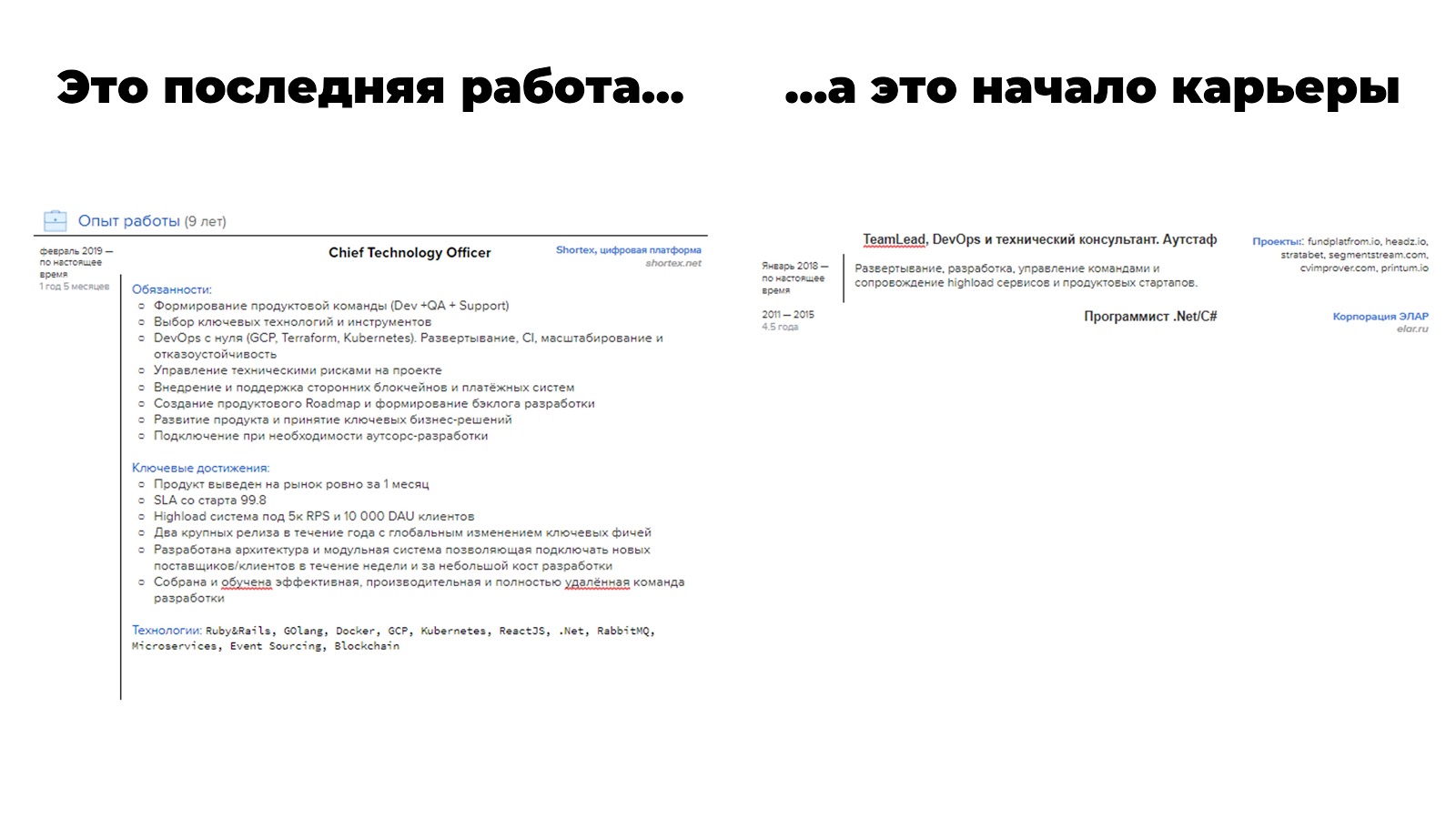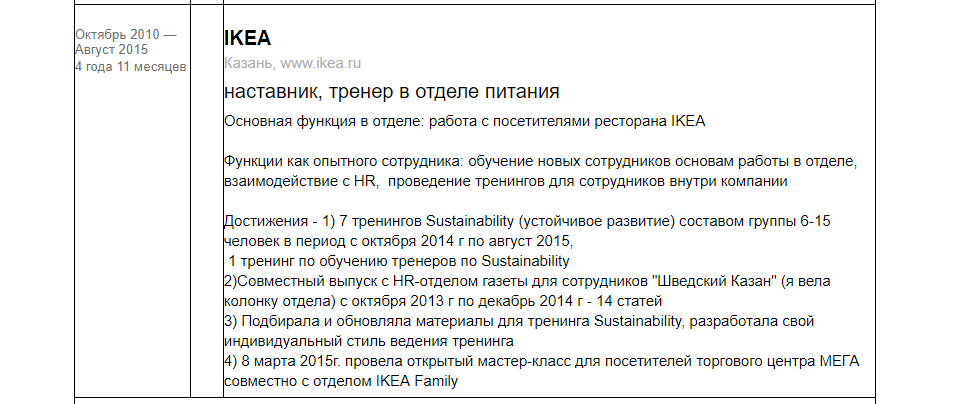
We at headz.io have worked with approximately 5,000 resumes of testers, developers, DevOps engineers, and other IT professionals to help them get the jobs they wanted. Therefore, we can tell you how to prepare a resume in order to quickly pass a recruiter or HR and please the employer.
Why do you need a resume
How is hiring usually done? For example, in a company that is looking at banking services, there is a need for a React developer. The team lead, tech lead, CTO orders HR selection of candidates: describes the project, tasks and gives a formal list of requirements. For example, this:

HR accepts the requirements, writes the text of the vacancy, posts it on the websites and at the same time looks for specialists on its own in order to quickly close the task. While the vacancy is open HR looks through a couple of hundred resumes and gets the same number of responses. They are all distributed like this:
- Hundreds of resumes are random. These are people who respond to everything - "maybe they will." These immediately go to the basket.
- A hundred more - juniors: a month of experience, but a wild desire to work.
- , , 95- .
- 50 , 10 .
- 30-35 , - — .
- 10-15 , ( ). (), , .
A recruiter spends about a minute on a resume . This is a normal situation when a recruiter has to look through several hundred resumes to hire one specialist. This is a standard recruiting funnel, which we also wrote about, for example, in the article How a CTO works for a recruiter . "
The task of a recruiter is to fill a vacancy faster . He / she will not read the resume, but selects only those specialists who pass on formal grounds. Therefore, the recruiter looks at the resume for about a minute ( or less ) "diagonally" - by keywords and phrases. If he finds what he was looking for, he puts the resume in a separate "pile" to pass them on to techies. It is logical that if the resume is "raw", then the chances of passing the recruiter are minimal.
Most hiring tech leads or CTOs require a resume . They look at inconsistencies, inaccuracies, learn from experience and achievements. Based on their resume, they select candidates who will be invited to interviews to test their personal and professional qualities.
The resume is the assemblage point . It contains "metadata" about the candidate: brief information, experience, links, by which you can learn more about you.
Hiring is a regular conveyor belt . The recruiter or HR has a heavy workload: he / she manually sorts hundreds of resumes, comparing the experience and skills of the candidates with the formal requirements. At the same time, the recruiter may not really understand who he is hiring, but he is forced to compare, like a robot, resume with requirements.
Therefore, the task of a resume is to pass the initial selection of a recruiter or HR in order to get to a CTO, tech lead or team lead for an interview, where you can fully reveal yourself as a professional and take a worthy place. The best gift for yourself (and for the recruiter) is a well-structured resume, by which the recruiter will be able to understand that you are suitable and will transfer you further. Let's consider how to prepare such a document.
Principles of a good resume
Globally, the resume consists of three pieces of information:
- Block with the companies you worked for.
- Block with technical expertise: experience, knowledge, abilities, skills.
- Work results or achievements.
Block with companies . Sometimes there are resumes in which there is nothing but a mention of work in a "cool" company, for example, in Yandex.

Two dry lines of experience of two years of work say nothing. Here the "cool" company is playing against the candidate. With such a resume, many questions arise: “What exactly did he do for two years at Yandex? What to pay 8,000 euros for? For a modest stack? And at what level does he own it? How will it be useful? " Perhaps this is a brilliant specialist in his field, but this is not clear from the resume.
It is not enough to write about working for a large corporation. This is just an added bonus - a trick that will make you spend more time on your resume. The employer's brand does not sell , it sells a well-written resume.
Technical expertise... This is experience, knowledge, skills and abilities that are beautifully packaged. It is important for a technician to fill out this block correctly, since an IT specialist is compared in technology first of all.
The customer sets tasks with clear instructions: "We need a JS developer to work with React for at least 2 years, plus Redux." Therefore, HR looks in the resume in order to "fish out" these parameters. Unless it is stated that you have worked with React for two years (and how exactly), then the resume will most likely pass by.
Achievements and results of work . Achievements are what you did better than before.
Even if you are still a junior, you still write achievements. For instance:
- graduated from the institute with the best marks;
- completed practical projects;
- studied at the school of programming.
Let's see how to implement all this “on paper”.
Resume structure
A good resume is divided into paragraphs and blocks of meaning. In the first block, the recruiter and his customer get to know you.
Hat . The study of you as a specialist begins with it.

There is a name, surname, photo and contacts: mail, phone, Telegram, Skype. It will not be superfluous to note how best to contact you - by phone or by mail.
Photography . For example, in Germany there is a resource Xing - an analogue of LinkedIn. A special place is taken by photography and candidates take photos in studios that specialize in photography for Xing.
In Russian-speaking IT, you don't need to bother like that. But it's good if there is a photo. A photo in business attire where you can see your face is a plus for your resume.

If you have the same resume everywhere (on all platforms and in social networks), with the same photo, this will greatly facilitate the work of the recruiter, and it will increase your chances of getting a new position.
Block "about me" . This is a story, a brief summary of information about you as a specialist.
For example, it is better not to write this way: template text "like everyone else".

We are all executive, responsible and stress-resistant. HR (and later a tech lead) is more interesting if you describe the main advantages, qualities, work skills, motivation in work, which anyway will be asked about and hobbies. For example, like this.

It would be ideal if the candidate added what frameworks he worked with so that the recruiter would not ask stupid questions: "Have you worked with Django / AIOHTTP / Tornado?"
Transmittal letter... Usually this is an additional block or a separate letter for the company you want to get into. In Russia, this part of the resume is rare, but in vain. After all, this is where you can tell why you are the right fit for the company. The letter should contain answers to the following questions:
- "What tasks can only you solve?"
- "Why do you want to get into this company?" Just don't write that you are looking for a high salary. Even if this is true and you are a truth-teller, many uncomfortable questions will arise.
- "Why is it pleasant to work with you, and what annoys you?"
- "What are you striving for?"
- "What working conditions are important to you?" For example, you want to work remotely, then you do not need fitness, VHI, or anything else that accompanies the office.
If you haven’t chosen an employer to whom you could write a letter, then a short and clear paragraph in your resume with an answer to the question "Why are you suitable for this job?" This text will proactively answer the uncomfortable questions of the recruiter, HR and CTO, and save you time and effort on contacts with the recruiter. And if you are still asked - there is a "blank".
work experience
This is a large block that we will "cut" into pieces. But first, an important rule:
The further back in time, the less you talk about the experience at that time.
For example, this is wrong.

Resume screen without details.
Here, work experience is unevenly distributed: almost nothing is said about the last place of work, but several paragraphs with details are given to the first one. But that's right.

There is no schedule of the entire "creative" path from the creation of the world: the last work experience is as detailed as possible, and less is said about the experience in the past, these blocks are shorter. It is important what you did in the last year, not at the beginning of your career.
If you have irrelevant experience, for example, as a manager at IKEA, then do not specify. For a developer, this is superfluous information, "burdens" the resume and is not interesting to anyone.

An example of the first work experience from a front-end developer resume.
about the project
In this block, you describe the project or projects that you worked on in the company at a certain period of time. Attach clickable links, describe the essence of the project, your role, how long you worked on and supported it, what problems you solved and what you couldn't. If there are any restrictions (NDA), please tell us how you can.
For example, it's better not to write that way.

This is a screenshot from a beginner Python developer's resume with projects and links. But there is one mistake: there is no answer to the question "Why does HR follow the links and view projects?" Most likely, HR will not do this - spend time and effort to figure it out.
To improve this block, it is enough to add to each project several sentences with project descriptions: the essence of the project, the role of the candidate, how long he worked on it, what problems he solved and what stack he worked with. For example, it might look like this.

Or so.

Note: Also, if possible, tell us about the company, colleagues, and the technology you used.
Duties
Do not include job descriptions.
Writing functional responsibilities from the job description on your resume is an easy way. Especially when everyone does it. For example, a standard resume list of responsibilities looks like this:
- development of new functionality;
- identification and correction of errors;
- release of releases;
- participation in the development life cycle;
- work on Agile, Scrum.
But here it is not clear what tasks the developer was engaged in, how complex they were, what solutions he came up with, what he rewrote, what proportion of the work in the project, what he learned and what failed.
A more detailed, expanded, and specific list of responsibilities works better. For example, this.

This description is already better than faceless and formulaic. It gives you an understanding of what kind of specialist you are, what you can be trusted, and what you are not doing.
Indicate specific actions on the project. The tester is engaged in integration, unit or autotesting, the team lead hires a team and trains, and the senior developer selects technologies for the project. With these data, we can already speak in detail, discuss. All this will be interesting for a technical specialist, who you will come to after HR. There is enough7-10 points - don't overload.
Key achievements
A resume is the best place for achievements. Achievements illustrate you as a specialist (especially from senior level and above) and tell the employer that you care "just to work to work."
For example, such achievements do not
mean anything : “Participation in the development of the Highload-system product. Stack: React, Redux, Node.js, FusRoDuh v3. "
But this is better.

Here you can see the benefits of the candidate's work.
Key achievements are measurable, achievable and time-limited - with numbers, timelines and qualitative changes.
Usually, for this, they take segments of six months and indicate the achievements for each of them. For example, we worked on a project for a year and brought a new product to the market from the idea stage to production in one month, or reduced the number of bugs in production by half (for QA).
In IT, people work in teams, and team achievements are more common. For example, we accelerated the time to market, released 10 new features during the year, exceeded the development speed by 10%, brought more customers or scaled x10 in volume. Feel free to list team achievements.
What should beginners do? Point out whatever you can for achievement.
- Read books, courses and tests.
- Your projects: applications, portfolio sites or a customized home cactus watering system on Arduino.
- Participation in meetups, conferences or hackathons. Add the result of the hackathon to your resume and it is no longer empty.
It doesn't matter at what level you are now, it is important how you have grown over the past year.
Technology
Relevant . Indicate technologies that are associated with specialization. It's not scary if the frontend specifies Docker or Kubernetes, but if there is nothing besides them, questions arise.
Fewer transfers . A set of technologies is not knowledge - it is a set of technologies.

If you add enumerations, tell us how many years you have been working with technologies, and dwell on some in more detail. For example, you write great scripts in Go, but you will never work with Django - add it, it will be interesting for the employer and tell more about you.
More markers... List the tools you own and work with in different combinations. The fact is that when HR looks (and searches for) resumes, they scan key combinations. For example, when Java is listed in a resume, HR looks for Kafka, and then its versions.
What should full stack developers do? Prepare three resumes:
- as a full stack to show that you are a versatile person;
- senior front-end developer;
- senior backend developer.
Each resume has its own key stack.
key skills
This block is convenient for CTO or HR: everything is collected in one place and you can see how the candidate assesses his skills and his level. But if the resume contains just a list of technologies, like this ...

..., then HR and the tech lead will not understand how well you own them.
Make their job easier by improving your hiring process. For example, this block might look like this.

But you don't have to bother so much. It is enough to add comments on technologies and skills. For example, like this:
- JS, CSS, HTML - more than 5 years, I know 5 out of 5.
- React, Redux, TS - 3 years, I know 4 out of 5.
- Node.js - 1 year, I study, I know 2 of 5.
Add a block "Education" here with a description of conferences, hackathons, courses and everything else that shows how you develop.
Note. Sometimes this block is combined with the previous one, since both technologies are indicated there.
Recommendations
Another plus for choosing you as an employee. Specify the persons who can recommend you and their contacts: mail, phone or links to accounts on LinkedIn.
For example, LinkedIn has a referral feature that can be used by your former colleagues or supervisors to recommend you. It inspires confidence and looks good.
Note. If you want to build a career, add recruiters who work in IT to LinkedIn. They know tech leads, CTOs and other recruiters and will recommend you first.
Check list
Let's summarize.
- A resume is not an autobiography or a set of information, but a business card that helps you quickly bypass the recruiter and get to the business customer for an interview.
- : , . , .
- — .
- — ,
- — .
- , , , , , .
If you take the structure above as a basis, then the resume will take 4-5 pages, which is quite enough. At the same time, it will not turn out to be too short and will not seem empty to the recruiter.
Most employers are not looking for ingenious developers. They need good enough specialists who can solve tasks on time without creating problems. And if a resume is convenient for HR and a business customer (they do not have to spend time and effort to understand it), then it is clear from such a resume that it is pleasant to deal with a candidate - it does not create additional problems, but makes life easier for the employer.
Note. Also keep your resume in several formats: PDF, PDF link (in the cloud), or Google Docs, which are easy to share.
, , — , . , headz.io, , , . Telegram- Headz, , , .